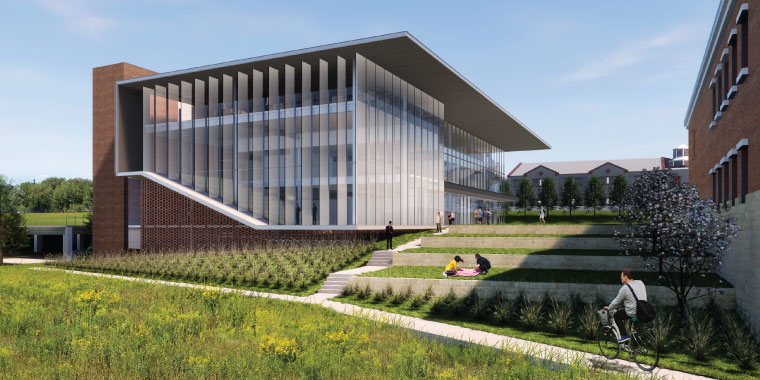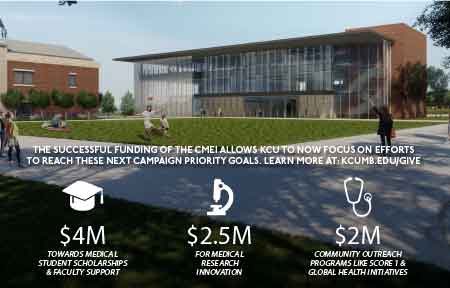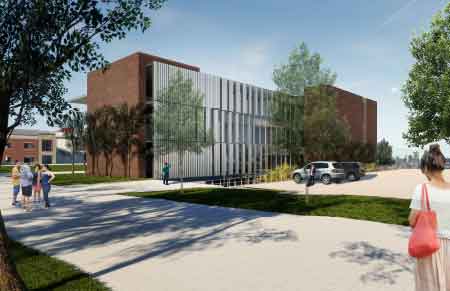KCU Secures $1M Challenge Grant

With a contribution from the Mabee Foundation, a fundraising milestone has paved the way for KCU's new center for medical education innovation.
By Krista Rogers
KCU is celebrating: The J.E. and L.E. Mabee Foundation officially awarded KCU a $1 million challenge grant to help build a new a center for medical education innovation (CMEI). KCU’s generous alumni, faculty, staff, friends and donors contributed more than $6.5 million to secure the Mabee challenge grant. Together, these gifts and grants funded the capital portion of the university’s comprehensive, $16 million Leading the Way campaign.
“This grant is a vote of confidence in our strength and direction,” said Jane Lampo, EdD, vice president for Advancement. Lampo explained that the Mabee Foundation engages grantee organizations in a unique way. Rather than a simple matching grant, the foundation requires an institution to raise a set percentage of their overall fundraising goal in order to obtain the challenge grant. In October 2016, KCU launched the push to reach that goal.
“And,” said Lampo, “we did it.”
 True to the focus of the fundraising campaign, the new CMEI facility demonstrates KCU’s leadership and innovation in educating future leaders in the health sciences. Spanning four floors and 51,000 square feet, the CMEI will provide enhanced opportunities for students to receive experiential training through "simulation."
True to the focus of the fundraising campaign, the new CMEI facility demonstrates KCU’s leadership and innovation in educating future leaders in the health sciences. Spanning four floors and 51,000 square feet, the CMEI will provide enhanced opportunities for students to receive experiential training through "simulation."
Whereas medical students used to learn many clinical skills by practicing on one another, today’s medical student learns through “standardized patients” in simulated medical settings. This kind of training uses actors as patients who can assess the clinical and communication skills necessary to provide high-quality patient care. Currently, KCU's facilities allow for 11 rooms dedicated to "standardized patient" experiences. In the new CMEI, the number of rooms will grow to 22.
Another way today's students are trained is through the use of mannekins – robotic "patients" who are programmed to display vital signs that actively respond to treatment and who are voiced by standardized patient actors from within a control center. Whereas KCU now has 4 rooms dedicated to mannekin-based simulation, the new CMEI will double that to 8 rooms.
In addition to expanding currently offered simulation opportunities, as the name implies, the new CMEI will be built with future flexibility in mind. The flexibility to adapt to ever-evolving advancing technology and educational delivery methods will enable KCU students to be prepared for real-life medical experiences they will encounter after graduation. The center also will create new opportunities for regional nursing and behavioral health students. The center creates an environment for interprofessional education, training different types of health professionals together, essential for a future that will see increased team-based care.
 “This was a wonderful project to walk into,” said Darrin D’Agostino, DO, MPH, MBA. D’Agostino joined KCU in the spring of 2017 – several months into the fundraising campaign – as executive dean of the College of Osteopathic Medicine and vice president for Health Affairs. He is keen to develop an integrated health professions program that will ultimately influence the health of an entire community.
“This was a wonderful project to walk into,” said Darrin D’Agostino, DO, MPH, MBA. D’Agostino joined KCU in the spring of 2017 – several months into the fundraising campaign – as executive dean of the College of Osteopathic Medicine and vice president for Health Affairs. He is keen to develop an integrated health professions program that will ultimately influence the health of an entire community.
D’Agostino emphasizes immersion, integration, and linkages between classroom and lab, and education and clinical practice. What’s unique here, he explained, is that the center will provide an environment that integrates traditional classroom education, simulation mannequins and standardized patients with virtual reality and augmented reality. As one component, simulation labs will use haptics technology – which is the ability to provide a tactile experience to the patient simulation experience. “For example, when a student palpates a ‘patient’s’ belly with haptics technology, now they can feel a warm, tender, firm mass,” he explained.
Working in the new center, KCU educators can immerse students in virtual worlds that link didactic or classroom knowledge with real-world, real-time scenarios. Many factors drive decision-making in a clinical situation, said D’Agostino. The new technology can introduce specific, changing elements of a patient’s condition along with the challenges inherent in team dynamics.
As the center enriches the quality of learning, it confirms KCU’s commitment to innovation in improving the way health professionals care for individual patients and ultimately affecting change in the overall health of a community.
The center represents both history and the future and provides tangible evidence of the university’s culture of philanthropy. “Many of our alumni were supported by donors when they were students,” said Lampo. “Their generosity and ongoing engagement is a way to pay it forward.”
The university expects to break ground on the 51,000-square-foot facility during the 2017-18 academic year.
KCU is grateful for the generosity of all the donors who have helped KCU meet the Mabee Challenge.
KCU also recognizes the contributions from over 80 percent of our faculty and staff who donated to the campaign.
Kenneth Mitchem, DO
The Sunderland Foundation
William T. Kemper Foundation
JE Dunn Construction Company
Brad Vince, DO
Victor E. Speas Foundation
Dr. and Mrs. Paul Dybedal
Riverside Health Foundation
Jack and Glenna Wylie Charitable Foundation